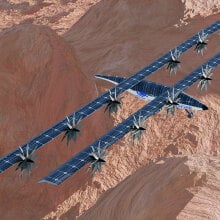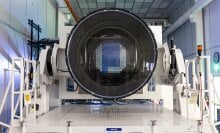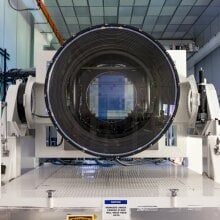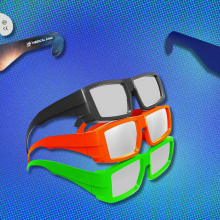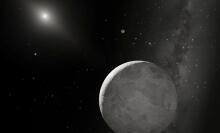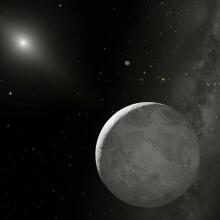Space is awfully psychedelic.
There are objects in the universe so massive — often clusters of galaxies — that they warp space, like a bowling ball sitting on a mattress. This creates a curved cosmic lens. "Light follows that bend instead of traveling in a straight line, distorting and brightening what’s behind the object," NASA explains.
A new image snapped by the James Webb Space Telescope, the powerful observatory orbiting 1 million miles from Earth, shows a galaxy warped by this effect — which is technically called "gravitational lensing" and was long ago predicted by Albert Einstein.
The Webb image below shows a sea of galaxies, some spiraled like our Milky Way. Near center-right is the warped and stretched galaxy MRG-M0138, which is located some 10 billion light-years away. This is an exceptionally old, distant galaxy, but the natural cosmic lens has magnified the light, making it appear vivid.

And in this magnified light, there's a surprise.
The close-up of the stretched galaxy reveals bright light from an exploded star, a violent event called a supernova. The researchers call it "Supernova Encore," and the giant gravitational lens makes it appear multiple times in this image, which you can see designated by the circles below.

What's more, the astronomers expect the lens to reveal yet another copy of this same supernova in the 2030s. This will allow astronomers a rare, invaluable chance to measure how fast the universe is expanding.
"When a supernova explodes behind a gravitational lens, its light reaches Earth by several different paths. We can compare these paths to several trains that leave a station at the same time, all traveling at the same speed and bound for the same location. Each train takes a different route, and because of the differences in trip length and terrain, the trains do not arrive at their destination at the same time," Justin Pierel, a NASA Einstein Fellow at the Space Telescope Science Institute and Andrew Newman, an astronomer at the Observatories of the Carnegie Institution for Science, explained in a NASA statement.
"By measuring differences in the times that the supernova images appear, we can measure the history of the expansion rate of the universe, known as the Hubble constant, which is a major challenge in cosmology today," the researchers added.
The Webb telescope's powerful abilities

The Webb telescope — a scientific collaboration between NASA, the ESA, and the Canadian Space Agency — is designed to peer into the deepest cosmos and reveal new insights about the early universe. But it's also peering at intriguing planets in our galaxy, along with the planets and moons in our solar system.
Here's how Webb is achieving unparalleled feats, and likely will for decades:
- Giant mirror: Webb's mirror, which captures light, is over 21 feet across. That's over two and a half times larger than the Hubble Space Telescope's mirror. Capturing more light allows Webb to see more distant, ancient objects. As described above, the telescope is peering at stars and galaxies that formed over 13 billion years ago, just a few hundred million years after the Big Bang.
"We're going to see the very first stars and galaxies that ever formed," Jean Creighton, an astronomer and the director of the Manfred Olson Planetarium at the University of Wisconsin–Milwaukee, told Mashable in 2021.
- Infrared view: Unlike Hubble, which largely views light that's visible to us, Webb is primarily an infrared telescope, meaning it views light in the infrared spectrum. This allows us to see far more of the universe. Infrared has longer wavelengths than visible light, so the light waves more efficiently slip through cosmic clouds; the light doesn't as often collide with and get scattered by these densely packed particles. Ultimately, Webb's infrared eyesight can penetrate places Hubble can't.
"It lifts the veil," said Creighton.
- Peering into distant exoplanets: The Webb telescope carries specialized equipment called spectrographs that will revolutionize our understanding of these far-off worlds. The instruments can decipher what molecules (such as water, carbon dioxide, and methane) exist in the atmospheres of distant exoplanets — be they gas giants or smaller rocky worlds. Webb will look at exoplanets in the Milky Way galaxy. Who knows what we'll find?
"We might learn things we never thought about," Mercedes López-Morales, an exoplanet researcher and astrophysicist at the Center for Astrophysics-Harvard & Smithsonian, told Mashable in 2021.
Already, astronomers have successfully found intriguing chemical reactions on a planet 700 light-years away, and as described above, the observatory has started looking at one of the most anticipated places in the cosmos: the rocky, Earth-sized planets of the TRAPPIST solar system.
Topics NASA



